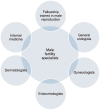A Schematic Overview of the Current Status of Male Infertility Practice
- PMID: 31385475
- PMCID: PMC7308239
- DOI: 10.5534/wjmh.190068
A Schematic Overview of the Current Status of Male Infertility Practice
Abstract
The practice of male infertility has dramatically evolved over the past few decades. This has been achieved after the realization of the important contribution the male counterpart holds in the couple's infertility. It is also supported by a number of breakthroughs in the diagnosis and treatment of this medical condition. Several tests to investigate sperm quality and function were introduced along with refinements and/or institution of novel surgical techniques that can correct several causes of infertility. This manuscript is aimed at highlighting the current state of male infertility practice in a robust, schematic method addressing a broader audience involved in the treatment of male infertility.
Keywords: Andrology; Hormones; Infertility, male; Oxidative stress; Semen analysis.
Copyright © 2020 Korean Society for Sexual Medicine and Andrology.
Conflict of interest statement
The authors have nothing to disclose.
Figures














References
-
- Steptoe PC, Edwards RG. Birth after the reimplantation of a human embryo. Lancet. 1978;2:366. - PubMed
-
- Nangia AK, Likosky DS, Wang D. Distribution of male infertility specialists in relation to the male population and assisted reproductive technology centers in the United States. Fertil Steril. 2010;94:599–609. - PubMed
-
- Mehta A, Nangia AK, Dupree JM, Smith JF. Limitations and barriers in access to care for male factor infertility. Fertil Steril. 2016;105:1128–1137. - PubMed
-
- Grey BR, O'Flynn KJ, Payne SR. UK urology trainees' exposure to dedicated infertility training: How good is that training? Br J Med Surg Urol. 2012;5:34–38.
Publication types
Grants and funding
LinkOut - more resources
Full Text Sources
Miscellaneous

